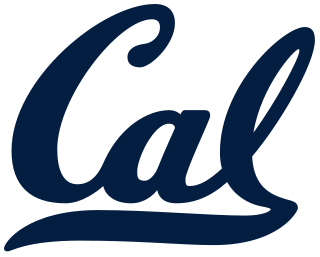Related Research Articles

Big Game is the name given to the California–Stanford football rivalry. It is an American college football rivalry game played by the California Golden Bears football team of the University of California, Berkeley and the Stanford Cardinal football team of Stanford University. Both institutions are located in the San Francisco Bay Area. First played in 1892, it remains one of the oldest college rivalries in the United States. The game is usually played in late November or early December and its location alternates between the two universities every year. In even-numbered years, the game is played in Berkeley while odd-numbered years are played at Stanford.

The Aggie Yell Leaders are a group of Texas A&M University students that lead Aggie fans in a series of "yells" during athletic events or other school events. The Yell Leaders are composed of five students who are elected annually by popular vote of the student body.

The Aggie Bonfire was a long-standing annual tradition at Texas A&M University as part of the college rivalry with the University of Texas at Austin. For 90 years, Texas A&M students—known as Aggies—built a bonfire on campus each autumn, known to the Aggie community simply as "Bonfire". The event symbolized Aggie students' "burning desire to beat the hell outta t.u.", a derogatory nickname for the University of Texas.

Homecoming is the tradition of welcoming back alumni or other former members of an organization to celebrate the organization's existence. It is a tradition in many high schools, colleges, and churches in the United States, Canada, and Liberia.
A fight song is a rousing short song associated with a sports team. The term is most common in the United States and Canada. In Australia, Mexico, and New Zealand, these songs are called the team anthem, team song, or games song. First associated with collegiate sports, fight songs are also used by secondary schools and in professional sports.
"Texas Fight" is the official fight song of the University of Texas at Austin and was written by Colonel Walter S. Hunnicutt in collaboration with James E. King, then director of the Marlin High School Band. The words, as finally adopted by the school, were written by Burnett “Blondie” Pharr, the director of the Longhorn Band from 1917-37.
The Aggie War Hymn is the war hymn of Texas A&M University; officially, the school does not have a fight song.

Cheering involves the uttering or making of sounds and may be used to encourage, excite to action, indicate approval or welcome.

The Texas Longhorns are the athletic teams representing the University of Texas at Austin. The teams are sometimes referred to as the Horns and take their name from Longhorn cattle that were an important part of the development of Texas, and are now the official "large animal" of the state of Texas. Generally, both the men's and women's teams are referred to as the Longhorns, and the mascot is a Texas Longhorn steer named Bevo. The Longhorns have consistently been ranked as the biggest brand in collegiate athletics, in both department size and breadth of appeal.

The traditions of Texas A&M University are a key aspect of the culture of Texas A&M University. Some of the school traditions date to the 1890s, shortly after the opening of the school, while others have been introduced more recently. These traditions encourage current students and alumni (Aggies) to cultivate the Aggie Spirit, a sense of loyalty and respect for the school, and dictate many aspects of student life, including how to greet others, how to act at an A&M sporting event, and what words a student may use in conversation. The most visible tradition among senior class students and alumni is the wearing of the Aggie Ring, whose design has been relatively unchanged since its introduction in 1894. Not all Aggie traditions are recognized by the university, and some, like Bonfire, have been discontinued for safety reasons. Texas Monthly states that the students' respect for school traditions and values is the university's greatest strength.
Elephant Walk is a tradition at Texas A&M University in which the senior class walks around campus to remember the good times they had at Texas A&M. This tradition generally takes place the week before the last regular-season football game, which before A&M's 2012 move to the Southeastern Conference was the Texas game. It signifies the last time that the seniors will stand as a part of the 12th Man student corpus.
The Spirit of Aggieland is the alma mater of the Texas A&M University. It was originally written as a poem by Marvin H. Mimms while he was a student at Texas A&M. Richard J. Dunn, the director of the Fightin' Texas Aggie Band at the time, composed the music. Students, faculty, and former students of the A&M sing the song at Aggie sporting events, Muster, and other events.

Hex Rally was a pep rally at The University of Texas at Austin that occurred in the week before the annual football game between the Texas Longhorns and their in-state rivals, the Texas A&M Aggies.

The RUF/NEKS are the nation's oldest all-male spirit squad of its kind for the University of Oklahoma and the 2nd oldest in the world.

Clean, Old-Fashioned Hate is the name given to the Georgia–Georgia Tech football rivalry. It is an American college football rivalry between the Georgia Bulldogs and Georgia Tech Yellow Jackets. The two Southern universities are located in the U.S. state of Georgia and are separated by 70 miles (110 km). They have been heated rivals since 1893.

The Texas A&M Aggies football program represents Texas A&M University in the sport of American football. The Aggies compete in the Football Bowl Subdivision (FBS) of the National Collegiate Athletic Association (NCAA) and the Western Division of the Southeastern Conference (SEC). Texas A&M football claims three national titles and 18 conference titles. The team plays all home games at Kyle Field, a 102,733-person capacity outdoor stadium on the university campus.
Many terms are unique to, or hold a special meaning connected with, Texas A&M University in College Station, Texas. The university, often called A&M or TAMU, is a public research university and is the flagship institution of the Texas A&M University System. It opened in 1876 as the Agricultural and Mechanical College of Texas, the first public institution of higher education in that state. In 1963, the Texas Legislature renamed the school to Texas A&M University to reflect the institution's expanded roles and academic offerings. The letters "A&M" no longer have any explicit meaning but are retained as a link to the university's past.

Texas Tech University traditions are an important part of the culture of Texas Tech University.

The Texas A&M–Kingsville Javelinas are the athletic teams that represent Texas A&M University–Kingsville (TAMUK) in Kingsville, Texas, in intercollegiate sports at the Division II level of the National Collegiate Athletic Association (NCAA), primarily competing in the Lone Star Conference (LSC) since the 1954–55 academic year.

The Texas–Texas A&M football rivalry is an American college football rivalry between the Texas Longhorns and the Texas A&M Aggies. The rivalry was played every year between 1915 and 2011, until A&M left the Big 12 Conference to join the Southeastern Conference during the 2010–12 Southeastern Conference realignment as a part of the wider 2010–2014 NCAA conference realignment. Texas currently leads the series 76–37–5. Texas and Texas A&M will resume this game starting on November 30, 2024as a part of the Southeastern Conference's rivalry week at the end of the regular season.
References
- ↑ Seungwoo Chun; James W. Gentry; Lee P. Mcginnis. "Ritual Aspects Of Sports Consumption: How Do Sports Fans Become Ritualized?". Acrwebsite.org. Archived from the original on 2011-07-23. Retrieved 2010-04-27.
- ↑ "College Athletics: History of Athletics in U.S. Colleges and Universities". Answers.com. Archived from the original on 2010-03-22. Retrieved 2010-04-27.
- ↑ "SBC – Red River Rivalry – Rivalry History". Jonholzer.com. Archived from the original on 2013-01-27. Retrieved 2010-04-27.
- 1 2 "Greatest College Football Rivalries from America's Best and Top Ten". Americasbestonline.net. Archived from the original on 2010-06-21. Retrieved 2010-04-27.
- ↑ "Purdue Official Athletic Site - Traditions". Archived from the original on 2011-07-27. Retrieved 2010-04-08.
- ↑ "The Little Brown Jug – Minnesota vs. Michigan". Gophersports.com. 1903-10-31. Archived from the original on 2010-09-27. Retrieved 2010-04-27.
- ↑ "USC Basics". USC. 1930-06-06. Archived from the original on 2010-04-17. Retrieved 2010-04-27.
- ↑ "Yells | Texas Aggie Yell Leaders". Texas A&M. Archived from the original on 2010-03-17. Retrieved 2010-04-27.
- ↑ "Texas Aggie Yell Leaders". Texas A&M. Archived from the original on 2010-03-05. Retrieved 2010-04-27.
- ↑ "About the Yell Leaders | Texas Aggie Yell Leaders". Texas A&M. Archived from the original on 2010-05-04. Retrieved 2010-04-27.
- ↑ "Notre Dame Fight Song". Mmbolding.com. Archived from the original on 2010-08-30. Retrieved 2010-04-27.
- ↑ "The Origin of the MSU Fight Song". msu.edu. Archived from the original on 2012-01-04.
- 1 2 "Oklahoma Sooners Football History". Collegefootballhistory.com. Archived from the original on 2010-08-21. Retrieved 2010-04-27.
- ↑ "Student Bonfire". Student Bonfire. Archived from the original on 2020-11-11. Retrieved 2010-04-27.
- ↑ "CNN.com - Texas A&M bonfire collapse blamed on structural, organizational problems - May 2, 2000". Archives.cnn.com. 2000-05-02. Archived from the original on 2009-08-13. Retrieved 2010-04-27.
- ↑ "Bonfire Memorial | Remembering Bonfire". Texas A&M. Archived from the original on 2010-03-05. Retrieved 2010-04-27.
- ↑ ""The Burning Desire" Documentary released on Thanksgiving". Aggieathletics.com. Archived from the original on 2009-11-29. Retrieved 2010-04-27.
- ↑ "Auburn Official Athletic Site – Traditions". Auburntigers.cstv.com. Archived from the original on 2011-08-12. Retrieved 2010-04-27.
- ↑ "University of Texas Alumni Association". Texas Exes. Archived from the original on 2009-11-28. Retrieved 2010-04-27.
- ↑ "A Brief History of the Penn State Whiteout". Bleacher Report. 2009-09-23. Archived from the original on 2010-11-04. Retrieved 2010-04-27.
- ↑ "MAroon OUT". Texas A&M. Archived from the original on 2010-07-08. Retrieved 2010-04-27.
- ↑ "Play Like A Champion Today". University of Notre Dame. 2004-11-12. Archived from the original on 2011-06-17. Retrieved 2010-04-27.
- ↑ "Sooner Tradition". SoonerSports.com. Archived from the original on 2010-04-23. Retrieved 2010-04-27.
- ↑ "Hawaii must not perform 'haka' with other team on field". ESPN. 2007-09-10. Archived from the original on 2012-11-04. Retrieved 2010-04-27.
- ↑ "Guns Up". Texas Tech University. 2009-02-18. Archived from the original on 2010-05-27. Retrieved 2010-04-27.
- ↑ "Traditions". Baylorbears.com. Archived from the original on 2010-12-25. Retrieved 2010-04-27.
- ↑ "Archived copy". Archived from the original on 2010-01-03. Retrieved 2010-04-08.
{{cite web}}: CS1 maint: archived copy as title (link)